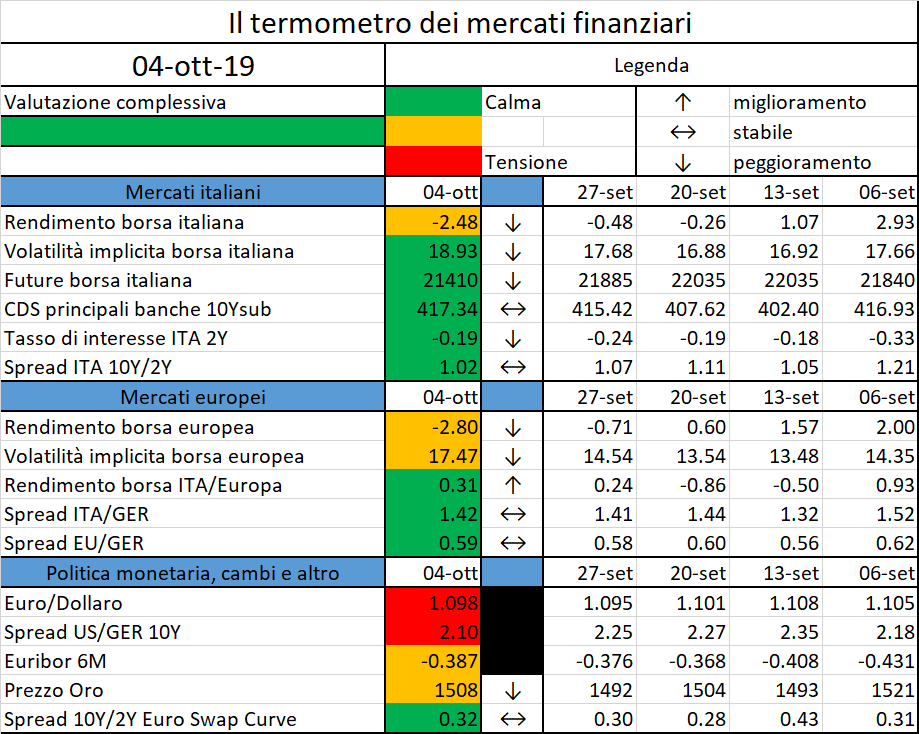Climate Change has been one of the most debated topics
over the last few months.
Having liked it or not, one cannot have staid
indifferent to the speech held by Greta Thunberg last 23 September at the 2019
UN Climate Action Summit, where the climate activist said: “we are at the
beginning of a mass extinction. And all you can talk about is money and fairy tales
of eternal economic growth”. Besides the scientific consensus on her side,
it is easy to agree with her ideals and her passion.
Back in 2012, in a more prosaic way, Christiana
Figueres, the former executive secretary of the UN Framework Convention on Climate
Change said: “climate change increasingly poses one of the biggest long-term
threats to the investments and the wealth of the global economy”.
Pensions, life insurances and nest eggs of
billions of ordinary people depend on the long-term security and stability of
institutional investment funds. This article provides an insights on how the
climate change has been considered so far in the insurance industry and in the
SII framework.
Last August 2018, the European Commission requested
EIOPA to provide an opinion on sustainability within Solvency II, with a
particular focus on aspects relating to climate change mitigation, due by 30
September 2019. To make it short, EIOPA thinks that undertakings should asses their
exposure to sustainability risk, but acknowledges that the medium to long term
impacts of climate change cannot fully be captured in the SII capital
requirements of Pillar I, that are designed to reflect the risk over a 1 year
time horizon. Complementary tools like scenario analysis and stress testing may
be more appropriate and included in the ORSA evaluation (Pillar II). Regarding
Pillar II, in the near future further considerations should be given to
mandatory requirements for public disclosure on sustainability risk on both
sides of the BS.
Beyond the outcome of this opinion, deeply discussed
in the following, it is important to recall that EIOPA is committed to the
international and European agenda on sustainability. In fact, the Authority is:
- engaged in the preparation on a sensitivity analysis exercise to assess the
risk embedded in undertakings’ portfolios for the transition to a low-carbon
economy to take place in 2020
- dedicating analysis for climate related risks in its financial stability
report and enhancing its supervisory stress testing methodology
- coordinating a catastrophe risk expert network to provide evidences on the
calibration of the standard formula parameters, the risk management practices
and private sector initiatives in addressing gaps in coverage of natural
catastrophe risks
- involved in the Commission’s work on developing a unified classification
system for sustainable economic activities (taxonomy)
- a member of the Network for Greening the Financial System.
To draft the opinion requested by the European
Commission, EIOPA collected evidences via a public call for evidence and a
confidential request for information conducted between January and March 2019
(at European level, solo and group participants represent approximatively 20%
and 38% of the total assets), plus a public consultation on a draft opinion
conducted between the 3rd and the 26th of July 2019 (answered by 26
stakeholders). The outcome of the opinion covers multiple goals, among which:
- understanding the extent to which sustainability and climate risk are
captured in the evaluation of Assets and Liabilities and understanding the
extent to which the Standard Formula calibrations and the Internal Models
designs are capable of taking into account sustainability factors and climate
related developments;
- understanding the extent to which sustainability and climate risk are
considered in the products designing and whether or not they are incentivised
by SII;
- collecting good practices on how to incorporate sustainability in the
investment and ALM phases.
Before deep diving into the opinion, it is important
to clarify what climate change related risks are and how they can be
classified.
Climate
change related risks obviously encompass extreme weather events, including
natural catastrophes, but also more general climate trends, such the rise in
temperatures, the rise of the sea’s level or climate-related forced migration
that could affect the insurance activity.
EIOPA classifies
the climate change related risks into three categories, proposed by the Bank of
England
- physical risk: related to specific weather events and longer term shifts in
the climate. It is expected to mostly impact real estate portfolios and,
indirectly, sovereign bond exposures (affecting the tourism), global supply and
availability of resources;
- transition risk: arising from the process of adjustment towards a low
carbon economy, due to developments in policy and regulations, emerging of
disruptive technology or business models or shifting of sentiment and societal
preferences. EIOPA is currently investigating to identify and quantify
potential climate transition vulnerabilities in the asset portfolios of
European insurers by tracing the extent to which they are accumulating of
reducing the risk in their corporate bonds and equity portfolios;
- liability risk: coming from people or businesses seeking compensation for
losses they may suffer from 1. or 2.. It is of concern for insurance
undertakings providing liability protection (e.g. professional indemnity
insurance).
Solvency II, that operates on a risk based framework,
is designed to take into account all quantifiable risks and requires insurers
to hold sufficient capital against those. The capital requirements are
calibrated to correspond to the VaR of the BOF of an insurance subject to a
confidence level of 99.50% over a one year period (Article 101 (3) of the SII
Directive). Therefore, the current design does not provide any positive or
negative incentive with respect to sustainable investments.
For
what concerns the Assets valuation, market prices should reflect all relevant
risks, including sustainability considerations. Unfortunately, the market
currently seems to be not that efficient because of a limited availability of
information on the sustainability profile of the investments: undertakings do
not value sustainable investments differently than other investments.
Improvement on data quality and collection of reliable information can help the
market to correctly price the sustainability risk. Scenario analysis should be
applied and mitigation strategies should be put in place. Some measures to
reduce sustainability risks can be taken into account in the valuation of property
risk as it is plausible that the value of a very energy efficient real estate
is less sensitive to energy price movements compared to other real estates. Equity prices are on the opposite influenced
by a broad variety of factors and, looking backward, it cannot even be assumed
that an asset currently considered to be green has always been green in the
past (examples of such transformations can be found in the energy sectors). The
spread risk module is mostly relevant for bonds and, therefore, it also has a
relevance for sustainable assets, especially in the area od project bonds
aiming at sustainable projects, like green bonds.
Regarding
the Liability evaluations, the majority (over 75%) of the undertakings
interviewed do not take into account climate or sustainability risks in their
best estimate calculations. Non-life (CAT) insurers implicitly consider climate
risks, but only based on historical data; the current calibration of the
Standard Formula parameters for the natural catastrophe risk module does not
explicitly include climate change risks. EIOPA suggests the need of capturing
those risks in a forward looking manner in the ORSA. Life business insurances
do not integrate the risks at all, even if climate change can have an impact on
the best estimate calculation though its effect on economic scenario
generators, health and mortality and morbidity rates. As it is not
straightforward for undertakings to account for sustainability and climate
change related developments in the Liabilities evaluations, they should perform
sensitivities and scenario analysis, using historical data combined with
scientific literature and forward looking models.
For what concerns the underwriting policies and
pricing decisions, the majority of the firms interviewed declared that they not
take explicit account of climate or sustainability risk in their underwriting
policies and pricing decisions. More than 80% of the Life Business responded
that climate risk is not applicable to them. Underwriting by itself cannot
mitigate a risk, it can only price a risk and, although higher prices can shift
the business to sustainable models, there are obvious commercial and societal
limits to repricing. EIOPA suggests to require undertakings to consider the
impact of their underwriting on sustainability factors and adjust the pricing
of products to reduce the risk and to have a positive impact on the
Environmental, Social and
Governance issues.
For what concerns the investment practices,
EIOPA considers it is relevant to require undertakings to take into account the
impact of their investment activity on sustainability factors. 70% of the
participants declared that they have already implemented practices to include
sustainability in their investment management / they are planning to do so in
the next three years. Nevertheless, undertakings noted that sustainable
investments are not less risky per se. The four major obstacles they have
highlighted in investing in sustainable investments are: 1) lack of data and
information on performance, 2) lack of commonly agreed taxonomy, 3) poor offer
and 4) impossibility to monitor climate change risks. The interviewed
undertakings have also pointed out the need for SII to remain risk based and
avoid imposing investment incentives. The main benefit of identifying green or
brown assets, if based on a European definition (taxonomy) of sustainable
activities, would be that investors will be better positioned to assess their
asset allocation against climate change objectives: such classification may
support thematic investments, but not general investment purposes. For
developed market equities it has been proved (cit. Black Rock Research paper
“Sustainable investing: a ‘why not’ moment”) that both risk and returns are
surprisingly similar for ESG (Environmental, Social and Governance) and non ESG
investments. Furthermore, while developments on a green taxonomy are ongoing,
no brown taxonomy has yet been developed at European level and it’s also not
straightforward to distinguish green assets (i.e. assets whose underlying
activity is considered to be sustainable) from others, as their risk profile
has many facets that it’s difficult to break it down into black and white.
Together with a lack of clear definition, there is also a lack of database for
the analysis of a long term trend in the associated risks.








